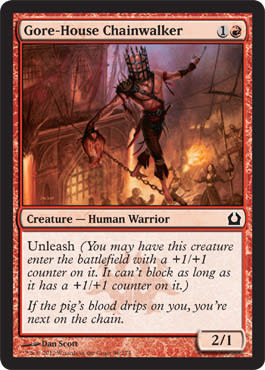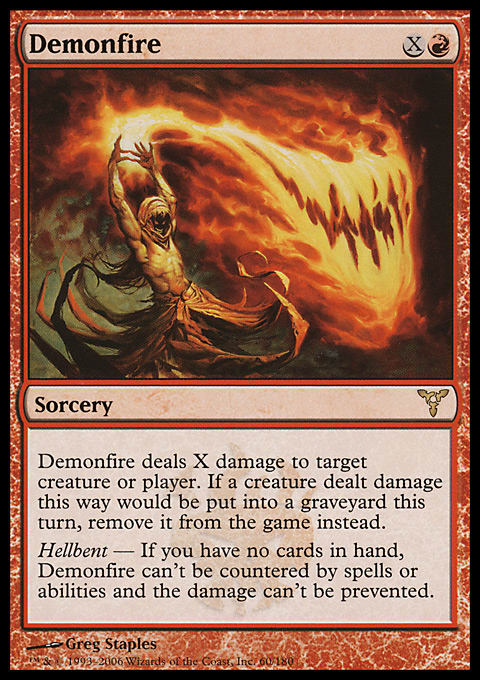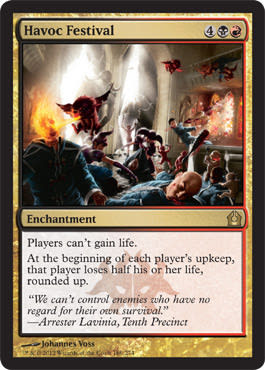Although black has a reasonable multiplayer pedigree, B/R isn’t considered the optimal color pair for large games. Multiplayer is the land of defensive measures, tough enchantments, and the need to deal with everything. B/R probably has the fewest defensive measures of any color pair, it can’t deal with enchantments, and it normally isn’t built for the long game. On the surface, it would seem that Rakdos isn’t your best bet for multiplayer dominance.
I happen to know someone who feels very differently and whose reputation with Rakdos backs it up. Buddy Renahan, the only ever guest writer at Muse Vessel, is a dad, social worker, and deacon by day but hellbent on unleashing some Rakdos (Psychotic? Chandra’s?) Fury on game nights. In the world of Magic writers, he’s among the most qualified in talking about B/R multiplayer strategies. I’m not qualified at all on it, so I’ve chatted with him this week (an interview would be too formal—white likes formality! Smash it!) to develop a coherent message for the kitchen table on Rakdos Week.
Firing up my Rakdos playlist1, here goes.
Offense Is the New Black . . . I Mean, Black/Red
At the very least, B/R gives a good power-to-mana-cost ratio at many spots on the creature curve. That’s obviously important in the early game, but it matters late as well. Sure, Gore-House Chainwalker might not be your idea of a great top-deck on the first turn after a board wipe, but it’s a sight better than Llanowar Elves. Green and blue are prone to late-game inconsistency in multiplayer—when all you need is a threat of any description, you might draw a mana dork or a counterspell. Rakdos has no such problem.
Rakdos usually can play a strong early suite of creatures backed by enough cheap removal to address initial there’s-The-Threat! targeting. It might peter out midgame from playing like that, but as long as it hasn’t incurred too much wrath in the early turns, usually someone else is The Threat by then, at which point, Rakdos can sit back a little and work on a plan to follow through on its early damage.
A Change in Mindset
Buddy confirmed what I suspected: Playing Rakdos in multiplayer requires different goals. For a long time, I’ve emphasized that since your odds of winning in multiplayer correspond to the number of players in the game—1 ÷ n—measuring your success in-game should be less about the official victory and more about optimal deck function. For Rakdos decks, this is an easy measure. How much damage did I deal? How many creatures did I kill? Multiplayer is blood sport, and Rakdos knows blood.
I’ve known many aggro/red mages become frustrated when they don’t win huge games, sometimes because they win more in duels and sometimes because they’ve been targeted disproportionately to their early games. Yet, those decks often deal the most damage over the course of a game; I encourage players to view that as a type of victory. According to Buddy, Rakdos has to live in that mindset to feel victorious on a regular basis, but once you’re in it, you’ll experience many a victory.
Along that line . . .
Rakdos Has Excellent Anti-Multiplayer Measures
I know Buddy to be drawn to these, but our conversations this week emphasized it: Rakdos can change multiplayer by contradicting Best Management Practices. If optimal deck function is a form of victory, forcing other decks to run suboptimally is a secondary happiness. This is especially true in Commander, but if you want to invest some deck slots in sixty-card Magic to something in the group both ubiquitous and obnoxious, go ahead. Regeneration bothering you? Black has loads of -X/-X effects. Hexproof getting you down/dead? Make them sacrifice creatures. Life-gain putting some players out of reach? Rain of Gore and Havoc Festival say “no.” Stranglehold’s obviously aimed at blue mages, but plenty of people take the ability to tutor for granted. Regeneration, hexproof, life-gain, and tutoring are all good ideas in multiplayer; Rakdos is great at stopping these shenanigans and focusing the game on creatures, damage, and creature damage.
Buddy recommends several cards along this line. Defiler of Souls is singularly nasty. The line of cards punishing players for having a large creature—Kaervek's Purge, Delirium, Backlash, and Traitor's Roar—can quickly besmirch a smirk. Din of the Fireherd can equalize The Threat as few cards can. There are other brutal instants, such as Cauldron Dance or Spontaneous Combustion, that can swing a game hard in your favor, and they tend to prey on multiplayer games building up a certain way most times. Rakdos is uniquely situated to foul up normal strategy. Learn how to fold that aspect into your B/R multiplayer decks, and you should see improvement. Again, it’s a mindset change to play with these cards, but they’re effective.
Hurry Up!
Rakdos is also well-suited to puncture interminable multiplayer board states. Through early damage, Havoc Festival, Insurrection, and similar cards, Rakdos is the best at forcing games to reach a conclusion. There’s also copious haste, which is hard to play around in multiplayer. As Buddy says about red’s contributions to Rakdos:
He might like haste. I can’t blame him. Haste, especially on steal effects, can let you take out a player who thinks the defenses are good for another turn. In the late game, especially on top decks, it’s not as though you can avoid playing your best creatures; you have to put something out there and just hope it doesn’t get stolen. Killing people based on things they can’t avoid is sound strategy; Rakdos thrives in that arena.
A B/R deck doing its thing moves games along so you can play more games. As much as I like rattlesnakes and protection, it is nice to play more than one game per night, and Rakdos is the best guild for that purpose.
Rakdos in Action
Given that B/R has some inherent blind spots, the pair gains far more than other colors when you stick it in a format that gives it access to other abilities. Nowhere is this more evident than Archenemy, where Buddy has, by my own attestation, one of the scariest combinations of deck and schemes:
"Deus Ex Schema"
- Creatures (14)
- 4 Plague Spitter
- 2 Avatar of Discord
- 2 Lightning Reaver
- 2 Dread Slag
- 2 Malfegor
- 1 Kaervek the Merciless
- 1 Rakdos the Defiler
- Planeswalkers (3)
- 1 Liliana of the Veil
- 1 Sorin Markov
- 1 Nicol Bolas, Planeswalker
- Other Spells (19)
- 4 Delirium Skeins
- 4 Anthem of Rakdos
- 3 Megrim
- 3 Leyline of Punishment
- 3 Torrent of Souls
- 2 Breath of Malfegor
- Mana (25)
- 12 Swamp
- 11 Mountain
- 2 Rakdos Signet
- Schemes (20)
- 1 All In Good Time
- 2 Every Hope Shall Vanish
- 2 Ignite the Cloneforge
- 2 Introductions Are In Order
- 1 Mortal Flesh Is Weak
- 2 My Wish Is Your Command
- 2 Only Blood Ends Your Nightmares
- 2 Perhaps You've Met My Cohort
- 2 Plots That Span Centuries
- 1 Realms Befitting My Majesty
- 1 Surrender Your Thoughts
- 2 Your Fate Is Thrice Sealed
Nine of the twenty schemes can disrupt opponents’ hands. Combined with Liliana of the Veil and Delirium Skeins, it is difficult to keep resources of any description. Not that Delirium Skeins is bad for Buddy; he wants to go hellbent so that Anthem of Rakdos becomes ridiculous. Since the Anthem doubles all damage sources, not just the ones that would benefit from the attack trigger, Breath of Malfegor, Megrim, Lightning Reaver, and anything brought back with Torrent of Souls (especially Dread Slag) becomes out of control quickly, while Plague Spitter becomes a better Mizzium Mortars.
As you might have noticed with those cards, just about every multiplayer boon is in here. Malfegor, Breath of Malfegor, and Lightning Reaver affect all opponents, while Plague Spitter and Delirium Skeins go to each player but are only bad for opponents.
The schemes also provide a few effects to make the deck consistently induce terror. Realms Befitting My Majesty and Your Fate Is Thrice Sealed give a land boost that allow Buddy to go big with everything. The deck mostly tops out at 5 mana, so he only needs one of these schemes to fix his mana for the rest of the game. Introductions Are in Order allows for some contouring (and who wants Buddy to find Kaervek the Merciless?), while Mortal Flesh Is Weak lets Buddy hit one opponent repeatedly with his evasive creatures, knowing that it will affect everyone in time, while backing up Leyline of Punishment in stopping life-gain, one of the principal ways opponents might try to survive this deck.
The hellbent/group-damage plan is scary regardless of format, but Archenemy brings out the best in Rakdos, and you have to come thoroughly prepared if you want to beat this deck. In its finished form, I don’t think I recall beating it ever. It’s as classic a Rakdos multiplayer deck as I could ever show, with several cards being the textbook examples of what the colors want to do in big games.
Conclusion
B/R might not be a classic multiplayer archetype, but it can be punishing with the right build and mindset. B/R excels at eliminating gummed-up board states that make for hour-long games, forcing opponents to actually do stuff, and that’s refreshing after enough games of rattlesnakes and trepidation. If you haven’t adopted the Rakdos mindset, give it a shot. It won’t hurt. It promises!
1 I have hour-long playlists for every color combination from zero to three colors based on color pie philosophy and how those ideas are expressed in music. My Rakdos playlist is:
- “Grey Area” by Blu Mar Ten
- “Pearls Girl (Tin There)” by Underworld
- “Skeletons at the Feast” by Spock’s Beard
- “Bowser Is Pissed” by PriZm (arrangement of Super Mario Bros. castle music)
- “Inamorata” by Animals as Leaders
- “Hollow Men” by Blu Mar Ten
- “Asylum” by Gary Numan
- “Descent” by VNV Nation
- “Szerencsetlén” by Venetian Snares
- “Close (VIP)” by Blu Mar Ten
- “Lilith” by Monolake
- “Entropy” by VNV Nation


























